Local Food Security During COVID-19: A Reflection
Local food is one thing I get really excited about. It is so damn important to close the gap between food producers and consumers. Buying local food means supporting our neighbours and local economies, using less plastic, saving the oceans, and becoming more healthy. There is no reason not to support this movement, people!
This post was born out of that excitement (and despair) when two months ago, my local farmer’s market shut down completely due to the COVID-19 pandemic. It blew my mind that something I’ve come to expect as a regular thing would shut, just like that! It didn’t happen to the big-box grocery stores, so why did it happen to my beloved farmer’s market?
Closure Confusion
The closure of the market also threw me for a loop. For the first time since I started going to farmer’s markets, I was actually at a loss. “Where am I supposed to go to find my veggies?” I thought. On this day, I had intended to visit my favourite produce vendor and restock my potato stash. You see, there’s a farmer in the Okanagan that grows the best potatoes ever (more about them later). I was so looking forward to diving into a bowl what you see below: local, lemony-dressed potatoes.
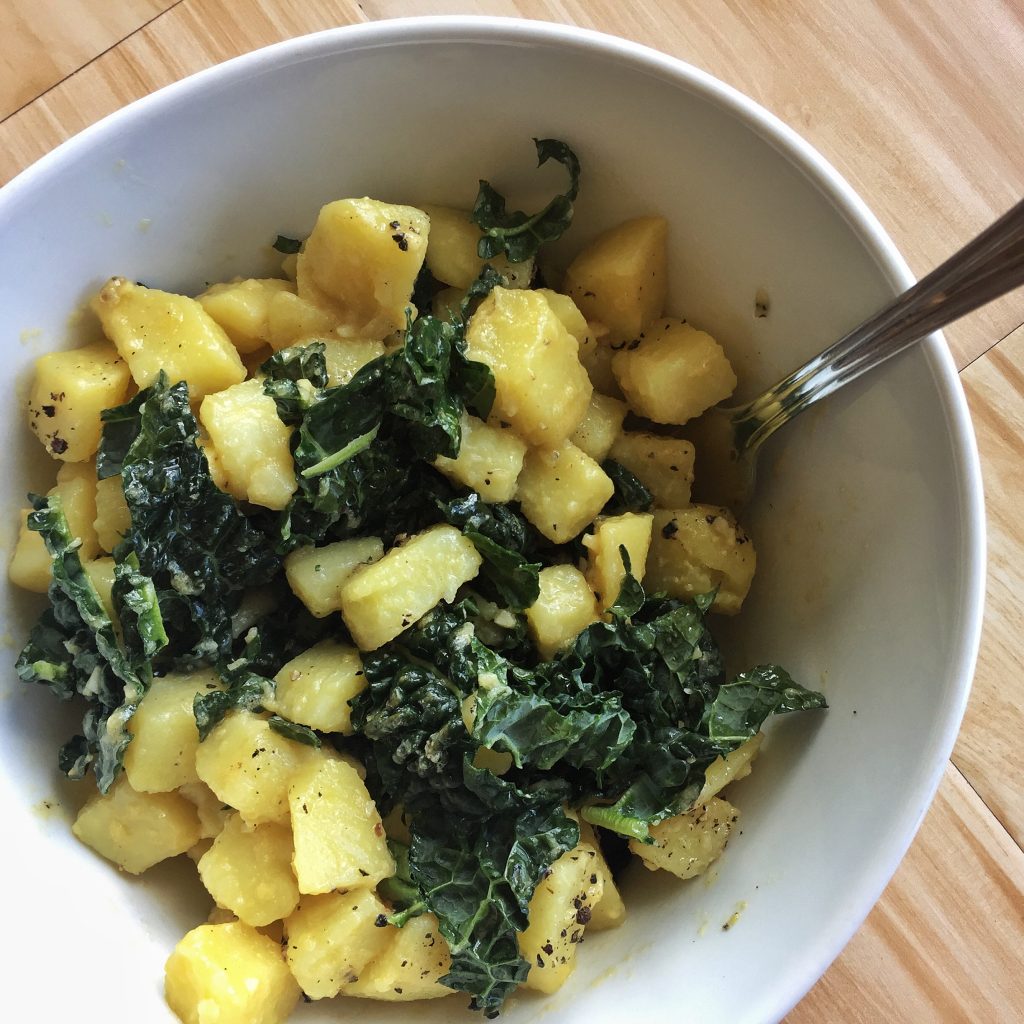
You might be thinking, “Wow, you are an idiot Ryan. Have you heard of a grocery store?!” And of course, I have. And I eventually went to one. Frankly, I’m lucky to even have access to a farmer’s market in the early spring (or even at all). I’m also lucky that this particular farmer has the ability to store their hardier crops (potatoes, carrots) and also chooses to sell them at various independent retailers. I ended up getting my dream potatoes from one such establishment, and peace was temporarily restored throughout the land.
Solutions to Local Food Access
This whole thing certainly made me think about how fragile our local food economy is. On the outside, it seems so robust and so simple. Farmers and food producers coming together with their goods to sell, and consumers meeting them halfway to make purchases. The original idea for this post then, was to discuss the farmer’s market model and dissect its pitfalls. I had grand plans to come up with solutions for improving access. It felt so…noble and lofty.
It was a good idea, I thought. Then, I talked to a farmer about this whole thing (yes, the same farmer who grows those lovely potatoes) and I decided it wasn’t such a great idea after all. I decided that what I actually found so fascinating about this whole shit show was the fact that people were straight up talking about local food…like, lots of people. Apparently the whole Internet was ablaze with stories of finding, growing, and eating local food. FINALLY!
Stories with Legs
This post took on a life of its own – from the original idea of talking about local food access, I began collecting more food stories and well, here we are. In May. Two months after my potato plight.
So, while I could go on a long-winded thought exercise about the merits of food cooperatives and list off all the ways in which COVID has brought us closer to our food, the truth of the matter is a) you didn’t come here to hear me yammer on about something I know very little about and b) that stuff is already out there. I have simply lost count and stopped trying to keep track of the amount of incredible art, graphics, and posts I’ve seen making their rounds around the Internet world, talking about the merits of local food in pandemic times. But you came here, presumably, to read up on some sustainability success – because that’s my bag – so Ima give that to you!
The [Local Food] Graphics That Started It All
Let’s go on a journey, shall we? Way back in early March 2020, when the tidal wave of COVID was just beginning to hit. Looking back now, it was our collective “Oh, sh*t!” moment. Back then, when farmer’s markets shuttered, then reopened but with strange and unsettling (albeit totally necessary!) rules (vendors wearing masks, waiting in line to visit your favourite farmer vendor…outside) – a very simple graphic started making its Internet rounds. The graphic is below, for your reference.
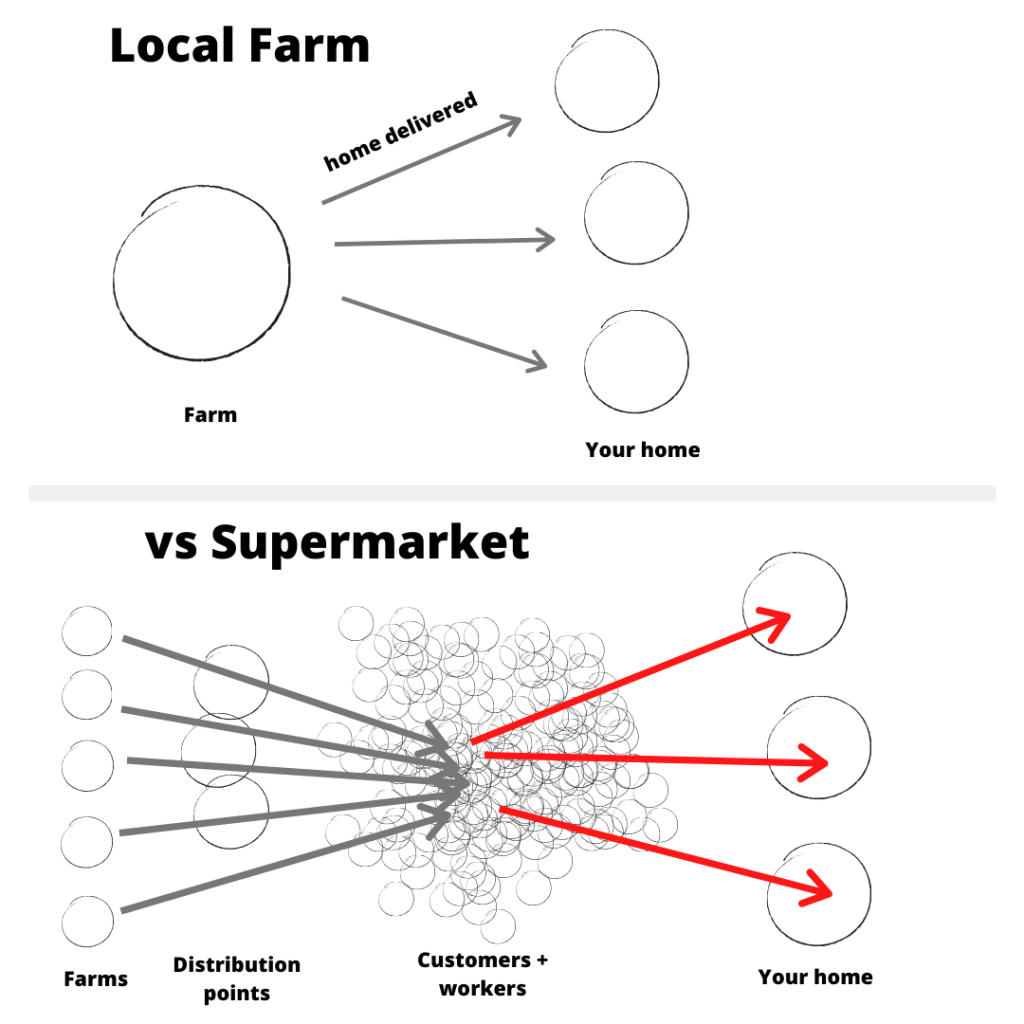
You may also have seen this graphic making its way around the Internet; it shows virtually the same thing: the simplicity achieved in our food system when we remove all of the middle men. The easiest way to remove all the food middle men? Simple: go to a farmer’s market.
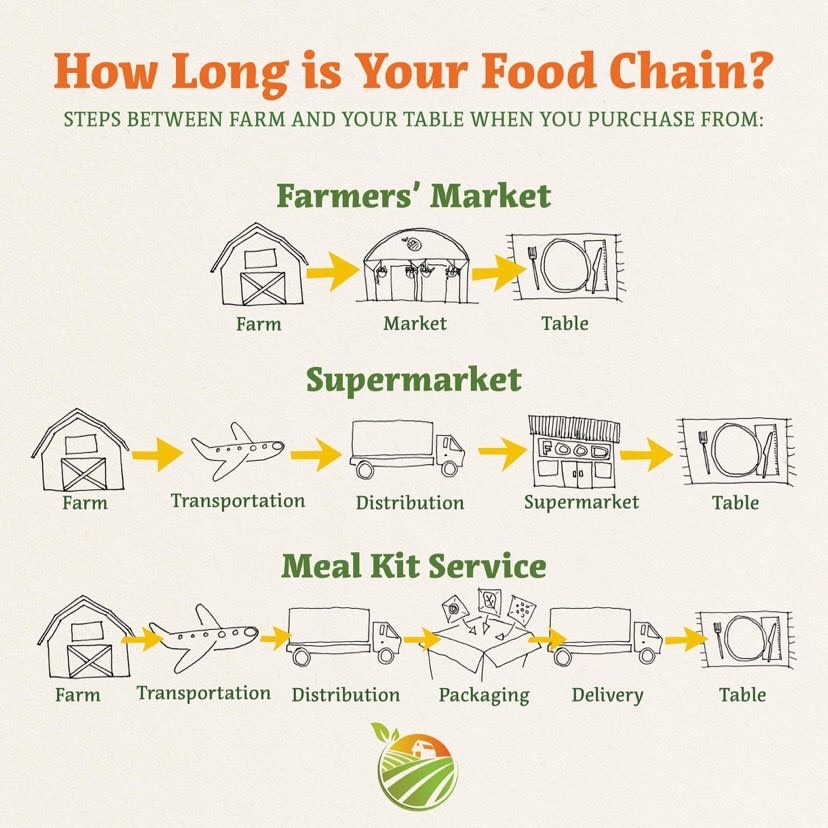
A Global Journey for Local Food
Wanting to use the first graphic in this post, but unable to find the original source, I went on a search that ultimately connected me with far more than an author for the graphic. As much as this post is all about local farms and food, my search for sources and information led me to a network of people and farmers from all across the globe.
I first put the word out to my Internet friends and colleagues on social media and with the help from a local chicken pal (in Kelowna) and an old college friend (in Massachusetts), tracked down the graphic itself and a secondary source – a farmer in Oklahoma. But it’s not over yet! That farmer found the graphic – inexplicably – from an urban farmer in…wait for it…NEW freaking ZEALAND. If you’d like to visualize this internet search, click here to go on a Google Earth Journey.
Crossing Oceans for Answers
Yep: Freeman Farms operates a 1/4 acre farm in New Plymouth, New Zealand, a town located on the west side of New Zealand’s North Island. When COVID began hitting communities globally, they produced the first graphic you see, a simple schematic highlighting the simplicity of local food purchasing.
I kid you not: the graphic I was so excited to use and properly source in this post, because it so perfectly, simply, and concisely pointed to the very thing that excites me about local food, and was making an impact in communities around the world, was drawn up by a farmer in New Zealand!!!!!
Keep that graphic in your mind as we continue on this local food reflection. Rather than me blabber on about lofty solutions to the problem of local food access though, for I am not the expert in those matters, I’d like to introduce a series of stories, from people who are out there, right now, doing what these graphics say and trying to make a difference.
Zelaney Farms – Coldstream, BC
Let’s start with Rachelle. Rachelle is the woman behind the operation growing those beautiful potatoes you see above (and spinach, carrots, broccoli). She and her husband own and operate Zelaney Farms, based in Coldstream, BC – a farm that has been in her husband Bryan’s family for over 30 years.
Zelaney Farms did not start out as a vegetable-bearing farm: 30 years ago, it was a hay field with no structures on it and nary a stem of broccoli in sight. Her husband’s family moved onto the land and slowly began coaxing beautiful produce out of it. As Rachelle puts it, “[They] farmed it into something that produces a whole lot of food for people.”
Rachelle did not grow up a farmer, but fell in love with locally-grown food early on, from harvesting potatoes and beans from her family’s urban garden, to summer jobs spent working on the very farm she now owns (how’s that for a full circle moment?!). She’s a science geek like me (we flock together, I think) and has been able to apply some of her academic training to farm life, which I think is totally badass and awesome. Oh and did I mention her daughters are future farmers, in love with soil and growing things?
Local Farmers Advocating for Local Food
What I love about Zelaney Farms (besides their incredible produce and powerhouse familial team behind the food) is their commitment to educating and supporting their customers in learning about and accessing local food.
When I spoke with Rachelle in April for this post (over Zoom; we followed the rules!), it was immediately obvious that she loves her job and is passionate about fresh, local food and farming. For those that follow Zelaney Farms on social media, this too is abundantly clear. Rachelle is always posting helpful growing tips for tomatoes and basil, and updating their followers about the farmer’s market status and where to access their food outside of the market. Despite all the chaos that this pandemic has caused – to farmers, in particular, carrying their share of uncertainty, unpredictability – she seemed upbeat, positive, and hopeful. Why?
“It feels so good to me to be able to say that when we sell our products, it’s coming directly from our farm – the land in Coldstream and nowhere else – and going right to the farmer’s market or to the small grocery stores that we supply, and right to the end user. There are no middle men, no delivery drivers or distribution centres; it’s going right from our farm to the end user. There is such value in that. The freshness of the product will be way more, it’s harvested sooner to when the end user receives it, and you’re lowering food miles, lowering greenhouse gases. There’s so much that goes along with supporting local agriculture and local food sustainability and security.”
Rachelle Zelaney, Zelaney Farms
Finding Peace of Mind in Local Produce
Simply put: because she too was noticing the spike in local-food interest. From her perspective, “It’s pretty cool to see that people are thinking about how they can have access to their own food in a time where convenience is easy and they can just go to Superstore, but they’re choosing to produce their own and support local farms when they can’t produce their own so that’s pretty amazing.” As we’ve seen with more and more factory-type food warehouses shut down due to virus-spread and various runs on certain food staples, it is becoming increasingly obvious that the general public is totally freaked out about food and really wants some peace of mind about it all, thank you very much. One great way to give that peace of mind is through…yup, farmer’s markets and fresh, local produce.
Says Rachelle, “It’s so incredible, because there’s that level of trust: you know exactly what you’re getting [and] you can ask questions like ‘When was this harvested?’ ‘Was it sprayed?’ ‘What kind of fertilizers are used?’ There’s a trust and a relationship between the farmer and the customer and there’s also the knowledge of how that food is produced, which is something that’s totally lost in the commercial food production scale of things with big stores.”
Farmers In the Spotlight
And, farmers are having their moment. Whereas before, farmers and farming have often played “behind the scenes” roles, never getting their moment in the spotlight, now they are the heroes of this pandemic. “…Local food security is something that is so important, and if we can maintain it and show that it is a viable career, then that is where we can potentially grow more young farmers.”
“Hopefully that encourages people that this is a worthwhile profession,” says Rachelle, herself a proud mom of two daughters who you can be sure love to get their hands in the dirt and grow their own food. When we chatted further, I discovered that that the massive heads of broccoli that Zelaney produces come late-summer, and that I eagerly anticipate each year (one head of broccoli is enough to feed my family several times over) are harvested by none other than Rachelle and Bryan’s oldest daughter. Each weekend, she goes with her dad to the fields and helps harvest the crop for the market and their retail outlet partners. I dare you to get a story like that out of big-box-store broccoli.
This sentiment is echoed by Dan Lamhonwah, an agrologist and hydrologist in the Cowichan Valley – a hotbed for the local food movement.
“Farmers are now being better recognized as front-line producers and community providers.”
Dan Lamhonwah
Cowichan Valley, Vancouver Island
I first met Dan at an environmental sustainability conference in Kelowna, in 2017. He is one of those quiet, passionate, multi-talented types and always happy to lend an ear and offer encouraging words. He too hails from the land of science (I tell ya, we flock together!) and researches permafrost on the sly. Dan now lives with his family in the beautiful Cowichan Valley region of Vancouver Island – I’ve not yet been but I hear it’s a beautiful, idyllic place, burgeoning with small-scale farms as frenzied urbanites retreat for calmer surroundings. His work as an agrologist is multi-faceted but generally involves him helping these new farmers draw up plans for land-clearing, on-site composting, and nutrient application and soil amendment, and he assists them navigate regulatory barriers.
The Importance of Local Food Security
As it stands now, BC exports almost all of its fresh food to other countries. We also and import most of the food we eat. This is frightening to me, when there is so much literal abundance in this province. Rachelle touched on this point during our conversation. She lamented that more people aren’t taking up farming, because of perceived barriers. Things like complicated regulatory requirements, land access, costs, etc. It was encouraging to hear from Dan that there are efforts being made to lower those barriers and bring new farmers into the fold. This is something we so desperately need for our own regional and provincial food security.
Local Food as a Priority for Health & Access
Back to the Cowichan Valley. There, locally grown food is something of a “business as usual” situation. “Communities here in the Cowichan Valley have generally placed high value in locally grown food, and much like many other communities, there is a growing movement towards attaining a higher level of food security here driven by health reasons, environmental stewardship and accessibility should supply chains be interrupted,” says Dan.
The COVID pandemic only re-emphasized this communities’ priorities towards increased health (for both the individual and the environment) and access to the abundance that surrounded them.
“With the general public wanting to limit shopping at grocery stores, there has been a very inspiriting surge of demand for local food purchased directly from farmers.”
Dan Lamhonwah
As more people jump into small-scale farming, there will be a need for professionals to help guide them to success. Luckily for the Cowichan Valley, Dan recently received his Professional Agrologist from the BC Institute of Agrologists. This means he can now lead farm projects and be an even bigger champion for small-scale farming. Way to go, Dan!!
The Paradox of Local Food Access
With all of this focus on local food, you would assume this to be a boon for our farmer friends. It’s fascinating then, that farmers are still struggling to figure out how to get their products to their customers. It’s a pickle, particularly for those farmers who rely on farmer’s markets and wholesale accounts (e.g., restaurants) for the majority of their sales.
Some have been lucky. Zelaney’s, for instance, long ago invested in the construction of a cold storage facility on their property. This allows them to a) grow more and b) store the extra produce for sale over the winter at markets and to their retail customers. The numbers are impressive: last winter, they were able to store close to 100,000 pounds of carrots and somewhere upwards of 45,000 pounds of potatoes.
Still others have been able to pivot their sales from markets to CSAs. One farm I spoke with a few weeks ago mentioned that since COVID hit, they’ve seen a near flip in the distribution of their income from market sales to farm CSA memberships.
Produce Pivoting
And of course, it has been absolutely amazing to see how quickly farmers and local food producers have pivoted to continue offering their goods in new and unique ways. The speed with which everyone hopped on board online shopping and delivery options really made my head spin! Virtually overnight farmers (at least here in BC) had online shops set up. Still others were connecting with delivery services to get their food to customers. From Dan in the Cowichan: “Many farms and food establishment who either source directly from local producers or who have a farm on their land are now offering delivery services.”
When I spoke with Rachelle about how they’ve been able to sustain their business, she noted that since they started their online store, they have seen sales go through the roof. Especially for things like tomato plants, as customers dig into their own gardens. When they launched their store, they were sold out of tomato plants in two and a half days. Aye carumba!
Food Uncertainty In the Time of COVID
Going back to the unpredictability piece. Even for seasoned farmers like Rachelle, or Elaine with Carpe Diem Raspberry Farm in Naramata, BC, this time is throwing a massive wrench in operations. Big questions remain: “How much should we be planting with an uncertain market come September?” “Will businesses be open to buy my produce?” “Should I even bother picking my produce if it’s just going to rot in storage and go unused?”
The pandemic is causing farmers and food producers to grapple with questions that have no answer, but that demand some kind of immediate action. Because of course, it is Spring and now is the time we plant and plan. Elaine wholesales the majority of her berries to restaurants and distilleries in Naramata and Penticton. With the tourism industry currently stalled, she’s unsure of where her berries will go once it comes time to harvest. Leaving them on the vine is simply not an option, from a moral standpoint (food waste) to an environmental one (rotten fruit attracts pests and disease).
Let’s Take a Pause
Wow. Are you tired? I’m tired and I haven’t even lifted a pitchfork. To say that farmers (and those who interact with farmers) are holding the weight of the world right now is a supreme understatement. I try really hard not to get preachy and tell people what to do, but for real: go find a farmer and buy something from them.
The idea for this post started out as a discussion about local food access in the time of COVID. It morphed into a success story tidal wave of farmers making a positive impact in their communities. From BC to New Zealand and beyond, it is evident that local food is rising to the forefront of people’s minds. This is so amazing I can’t even begin to describe my glee. Of course, this glee is tampered with the knowledge that this pandemic has caused untold sadness and devastation globally. But, I’m an eternal optimist, hell-bent on finding the silver lining.
Because of that, I’d like to conclude this story with some beautiful words shared by my friend Dan. He so eloquently stated what I’ve been feeling about the renewed interest in local food these last couple of months:
“Although we are in challenging times, I see so much good to come out of this crisis. In fact, good has already come from the challenge and sorrow. Communities are being strengthened. People have a better sense of where their food comes from. We are learning not to take things for granted. All of this gives me hope.”
Dan Lam
Final Produce Ponderings
Here we are, in May: my beloved Kelowna farmer’s market is back and starting to explode with fresh rhubarb, asparagus, and other fresh delights. Our communities and buying experiences look very different and more people are being pushed to grow their own or investigate that “farmer’s market thing that happens twice a week,” and nobody is sure when and if we’ll ever return back to “normal.”
I would argue that “normal” wasn’t really working for us anyway and that maybe – just maybe – the influx of awareness of and emphasis on purchasing local sustainable, more healthful and delicious, food should become our new normal. That’s a scenario I can totally get behind.


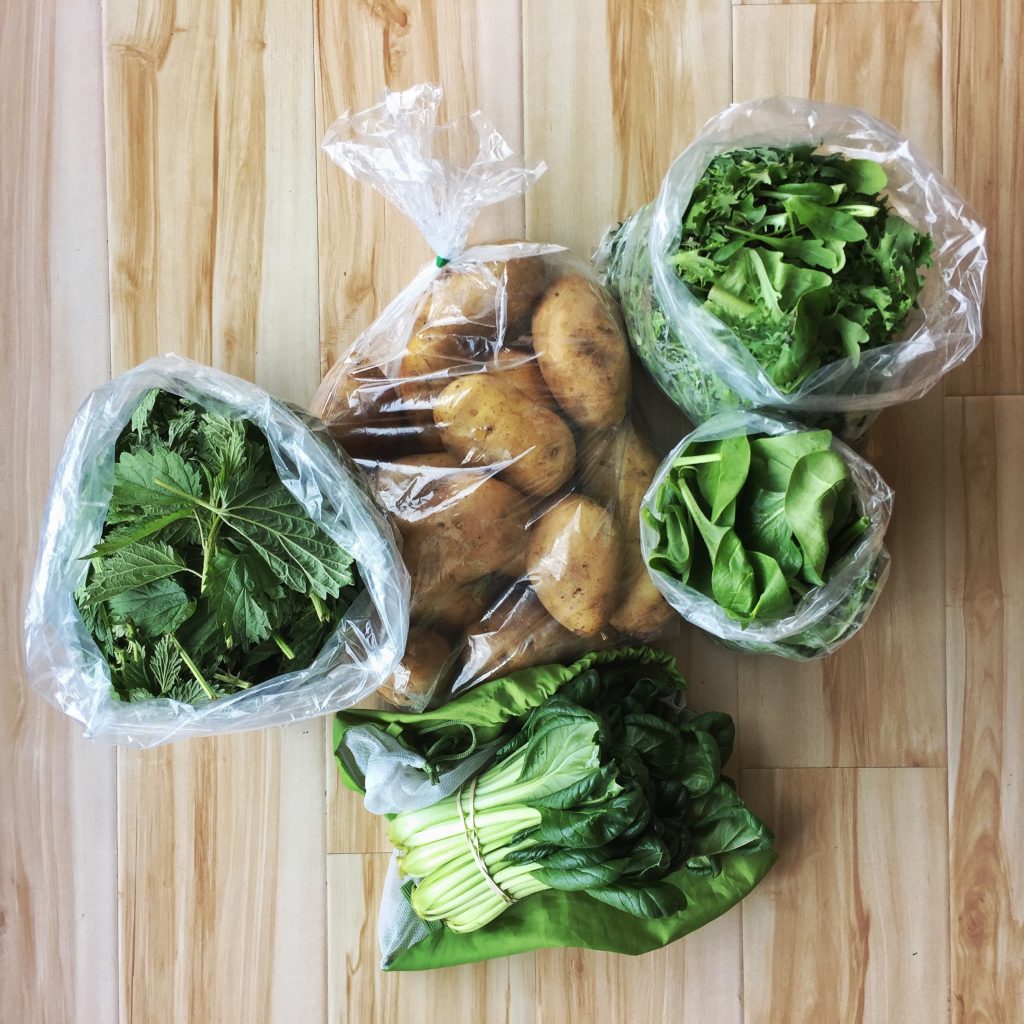
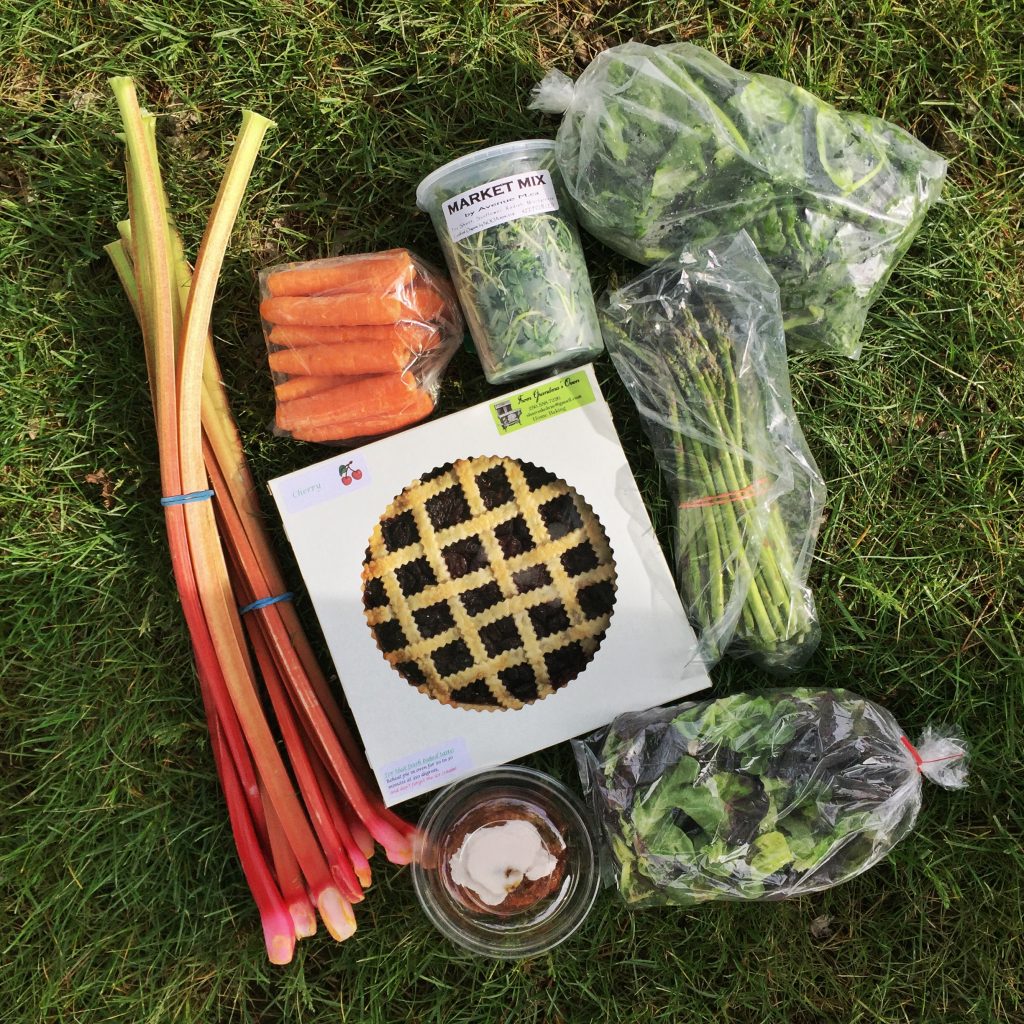
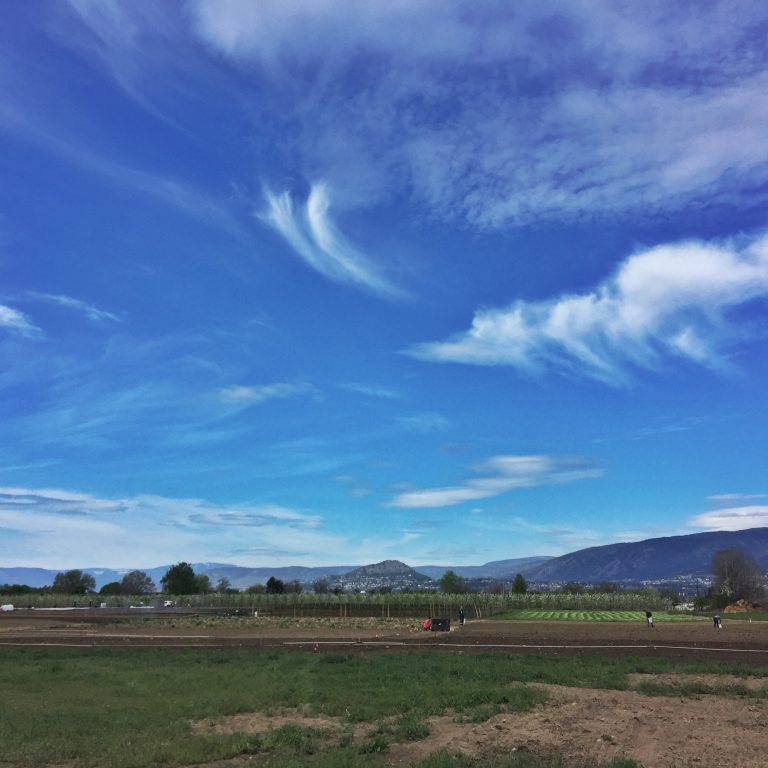
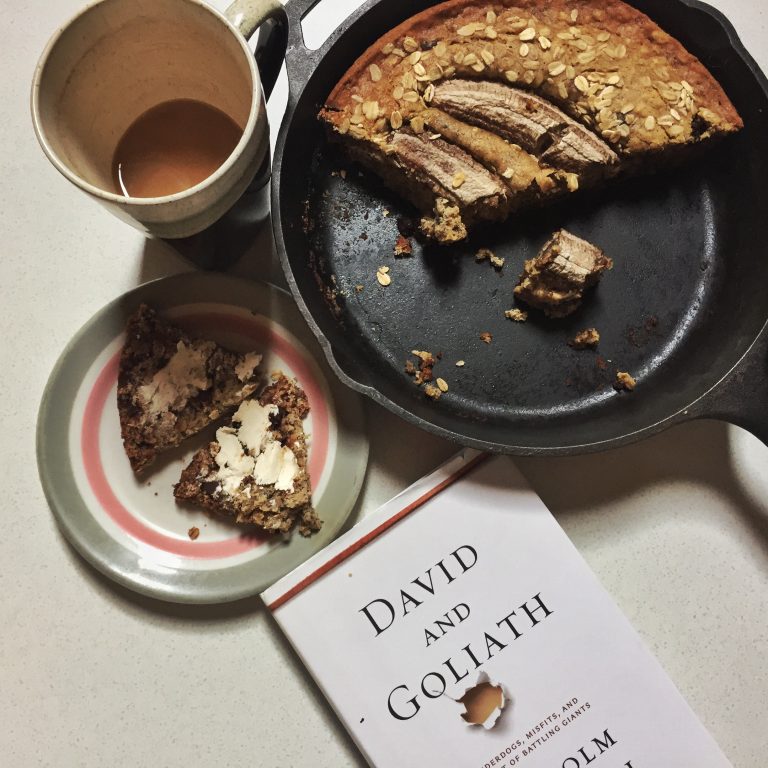
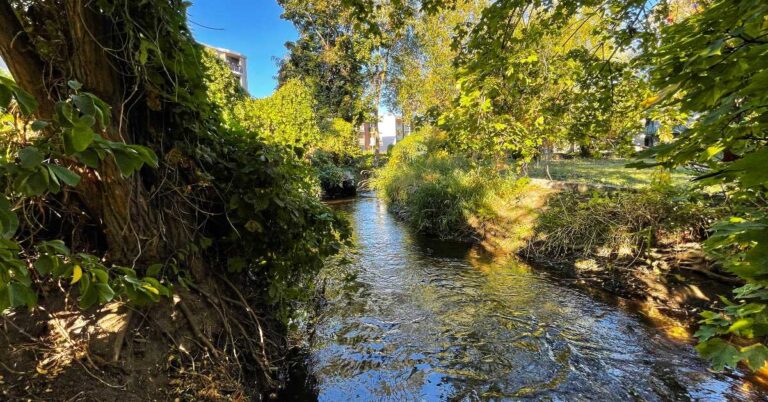

A wonderful article. Covid-19 has opened my eyes on how important Farmers and our Food Chain is. Being a Farmers Market Coordinator, now I see where I need to educate my customers as well as myself. Thank you
Hi Frances, and thank you so much reading this, and for your comment! I’m so sorry for not responding to it sooner. I would love to chat with you sometime about your experiences as a Market Coordinator!